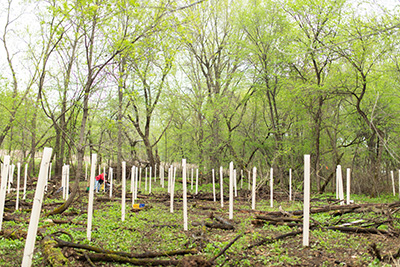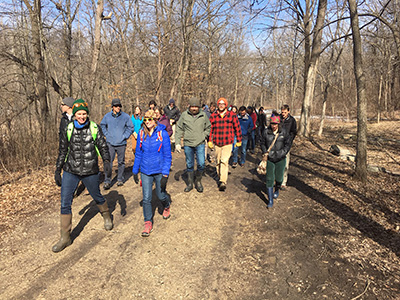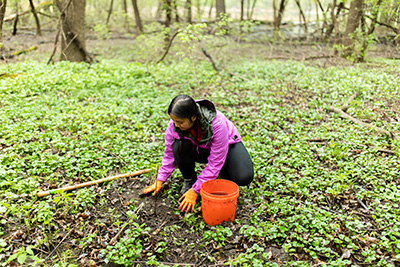A team of natural resource specialists from Colorado State University, the Mississippi Park Connection, Saint Paul Parks and Recreation, and local collaborators teamed up with regional scientists from the University of Minnesota and the Northern Institute of Applied Climate Science to participate in a two-day workshop in March 2019 to develop the ASCC treatments for the first urban affiliate site at Crosby Farm Regional Park. The team developed a set of management objectives, desired future conditions, and silvicultural tactics for each adaptation option:
RESISTANCE
maintain relatively unchanged conditions over time
Management Goals:

- Maintain a closed canopy condition
- Maintain the current species composition in the tree canopy and regeneration layer of the floodplain forest ash-elm species
- Promote or enhance native regeneration
- Manage to decrease invasive species cover (trees and herbaceous layer)
- Maintain large diameter trees while creating a range of diameter classes for wildlife habitat
- Maintain vigor of existing desirable trees
- Maintain recreation value and opportunities for multiple use of the area
- Strive for an educated and engaged public
Strategies & Approaches:
- Site prep for natural regeneration and planting
- Scout, treat, and remove invasive plant populations
- Create gaps for regeneration using the following prioritization:
- Utilize natural gaps (dying ash pockets/cottonwood gaps) for regeneration
- Remove “hazard” trees from trails (hazard removal is the priority for all treatments including control/no action)
- Create additional gaps for regeneration of desired species if natural gaps and hazard tree removal options do not provide enough opportunities for desired species regeneration
- Maintain large diameter trees, particularly silver maple and cottonwood, as well as large-diameter standing dead for wildlife habitat and eagle nesting
- Consider treating selected large ash
- Plant under-represented species that currently grow on site: silver maple, hackberry, cottonwood, and Dutch-elm resistant American elm seedlings to help maintain the floodplain forest ash-elm cover type
- Protect all regeneration from herbivory using deer exclosures around plantings
- Allow natural flood deposition and use as microsites for planting future-adapted species
- Use volunteers and increase visitation, education, and use of Crosby Farm Regional Park as a teaching forest
RESILIENCE
allow some change in current conditions, but encourage eventual return to original conditions
Management Goals:

- Promote a broad suite of future climate-adapted species (flood-tolerant and drought-tolerant) native to the Mississippi River Basin
- Promote less common native species
- Promote trees with vigor and seed potential
- Low herbivory
- Low abundance of invasive species
- Provide wildlife trees with big crowns and cavity trees or snags for nesting wildlife species
- Maintain recreation value and opportunities for multiple use of the area
- Strive for an educated and engaged public
Strategies & Approaches:
- Site prep for natural regeneration and planting
- Scout, treat, and remove invasive plant populations
- Create gaps for regeneration around high-value, large-diameter seed trees using the following prioritization:
- Utilize natural gaps (dying ash pockets/cottonwood gaps) for regeneration
- Remove “hazard” trees from trails (hazard removal is the priority for all treatments incl. control/no action)
- Create additional gaps for regeneration of desired species if natural gaps and hazard tree removal options do not provide enough opportunities for desired species regeneration
- Create skips in areas where the canopy cover target is important
- Plant species that are currently found onsite using a southern seed zone location (silver maple, hackberry, cottonwood, Dutch elm-resistant American elm, bur oak, black willow)
- Plant species that may currently be offsite but within geographic range of the Mississippi River Basin (swamp white oak, river birch, peachleaf willow, red mulberry, Kentucky coffee tree)
- Plant species on appropriate microsites, especially with respect to potential changes in flooding regime and hydrological changes with climate change
- Protect all regeneration from herbivory using deer exclosures around plantings
- Allow natural flood deposition and use as microsites for planting future-adapted species
- Use volunteers and increase visitation, education, and use of Crosby Farm Regional Park as a teaching forest
TRANSITION
actively facilitate change to encourage adaptive responses
Management Goals:
- Promote a broad suite of future climate-adapted species (flood-tolerant and drought-tolerant) from seed zones farther south along the Mississippi
- Create a diversity of canopy cover conditions over space and time that is heterogeneous for regeneration
- Promote heterogeneous age classes and canopy structure
- Maintain recreation value and opportunities for multiple use of the area
- Strive for an educated and engaged public
Strategies & Approaches:

- Site prep for natural regeneration and planting
- Create gaps that are ideally 1 acre to 1.5 acre to accommodate selected species, avoiding river edges while creating a variety of microsites for species
- expand gaps with feathered edges
- girdle trees on edges
- create microsites for planting
- Plant containerized and bare-root stock of sycamore, honey locust, southern pin oak, swamp white oak, river birch in the gaps; and winged elm, red maple, red mulberry, northern catalpa along the edges
- Treat invasives where they are impacting regeneration
- Monitor for stressors and survival and adjust as needed (adaptive management)
- Protect all regeneration from herbivory (deer and beaver) using deer exclosures around plantings, but also consider alternative options of fencing, repellent, and seedling tubes
- Retain large-diameter standing dead for wildlife habitat
- Allow natural flood deposition and use as microsites for planting future-adapted species
- Use volunteers and increase visitation, education, and use of Crosby Farm Regional Park as a teaching forest


